Contributed By
Published
Although these comic strips contain no words, Arzach resembles the original Panzer Dragoon due to the imagary of a winged creature riding across a mysterious alien world.
Contents
- Introduction
- A Different Kind of Dragon Rider
- Dream-Worlds
- Mystery and Silence
- Contrasts
- Moebius’ Involvement with Panzer Dragoon
Introduction
The Panzer Dragoon series has always been noted for its strikingly artistic visual style, and also for the beautifully surreal fantasy world that it depicts. Every artist and designer finds their inspiration somewhere though, and when Team Andromeda set about creating the very first Panzer Dragoon game, several members were fans of the renowned French comic book artist Jean Giraud. Giraud’s career began back in the 1950s, and since then he has illustrated a prolific number of comic strips covering a variety of genres. It appears that his work was one of Team Andromeda’s general inspirations for the overall style of their games, and one of Giraud’s creations seems to stand out in particular as an influence for Panzer Dragoon: the Arzach comic strips.
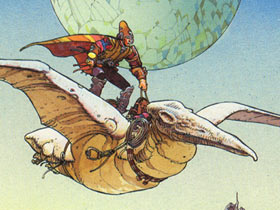
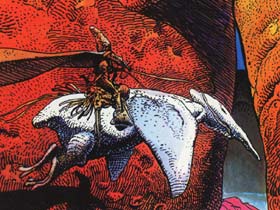
Giraud created the Arzach strips in the 1970s, and they were first published in the French comic Metal Hurlant. Arzach is one of several works that Giraud has produced under the pseudonym “Moebius”, and it apparently had a significant impact on the comic world of the period. Arzach depicts the journeys of a grim and lonely warrior – Arzach himself – who travels over surreal landscapes on the back of a pterodactyl made of stone. The vivid, dream-like illustrations are strikingly detailed, but what makes Arzach quite unique is the complete absence of any dialogue or script; free from speech bubbles and text boxes, the strips focus entirely on artwork as a storytelling medium.
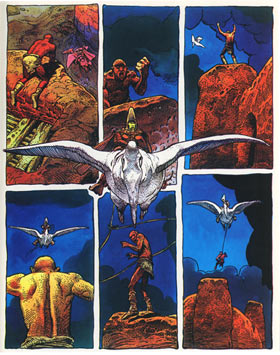
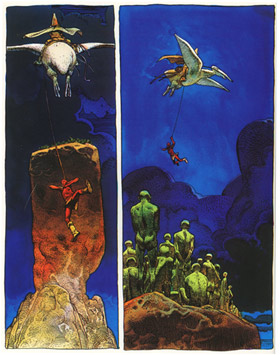
A Different Kind of Dragon Rider
Despite what the gaming press has implied from time to time, the Panzer Dragoon series is not directly based on Moebius’ works, and they were only one of Team Andromeda’s many inspirations. Several of the visual themes in Moebius’ fantasy artwork do seem to be reflected in the games though, and there are certainly parallels between Panzer Dragoon and Arzach in particular. Both tell the story of a “dragon rider”, a character who flies across a strange world on the back of an unconventional creature; Panzer Dragoon features a bio-engineered dragon, while Arzach travels the wilderness atop a stone pterodactyl.
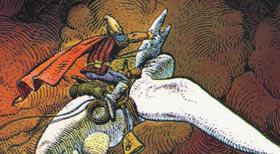
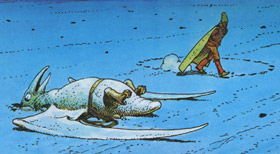
From an aesthetic point of view the Panzer Dragoon dragon and the Arzach pterodactyl are similar in several ways, but what Arzach’s pterodactyl may also have influenced is the design of the bio-monsters that appear throughout the Panzer Dragoon games. Like the pterodactyl, the Panzer Dragoon world’s “pure-type” monsters have white, stone-like bodies, and it’s often unclear if they’re meant to be organic, mechanical, or a combination of both. Similarly, the pterodactyl initially appears to be a living creature – Arzach is seen feeding it during the second story – but in the third story the creature “breaks down” in the desert, and it is only revived by the intervention of an otherworldly mechanic.
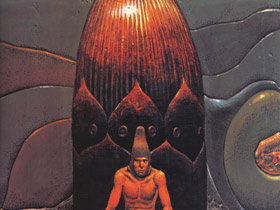
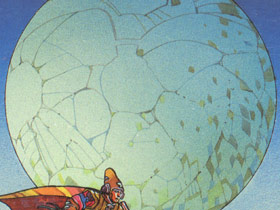
A noticeable similarity between Team Andromeda’s visuals and Moebius’ is the artists’ tendency to incorporate chaotic, asymmetrical lines into their designs; in Panzer Dragoon this is most apparent in the ruins and bio-monsters of the Ancient Age, which are usually covered in strange, flowing line motifs. Moebius seems to make a similar use of lines and cracks in many of his visual creations, as the above images illustrate; admittedly this is not as common in Arzach as it is in some of Moebius’ other works, though.
Dream-Worlds
One of the more obvious similarities between Panzer Dragoon and Arzach is the nature of the world that each series uses as its setting; although the details are certainly different, these two fantasy worlds revolve around many common themes. The visual imagery of Arzach conjures up an eerie and hostile dream-world; the landscape itself is barren and desolate, littered with the bones of monstrous creatures and the bizarre ruins of ages long forgotten. The few creatures that inhabit the decaying land are monstrous, the people savage, and the only plants Arzach comes across consume living creatures alive.
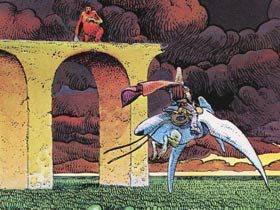
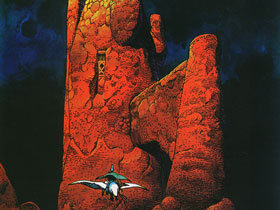
Although Team Andromeda’s games aren’t so extravagantly dark as Arzach, it does seem likely that the bleak world of Panzer Dragoon found several points of inspiration here. Both of these worlds also feature an uneasy contrast between primitiveness and technological advancement; the Panzer Dragoon world may be populated by simple human societies, but it is also home to the technological legacies of the Ancient Age – the ruins and bio-monsters – which seem to be beyond human understanding. Similarly, Arzach’s pterodactyl appears to be a sophisticated mechanical or bio-mechanical creature, and although his world seems to be populated by only monsters and savages, it too has its share of bizarrely advanced technologies. All of this further blurs the lines between fantasy and science fiction, past and future, giving these abstract settings an even more mysterious feel.
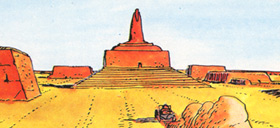
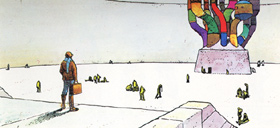
But of course, these similarities are fairly general, and many of these elements are common to other dark science fiction or fantasy worlds; indeed, beyond the general premise of a “dragon rider” flying through a dream-like world, Panzer Dragoon finds much of the inspiration for its subject matter elsewhere. However, while some other works (such as Hayao Miyazaki’s Nausicaä of the Valley of the Wind manga) feature a very similar world and storyline to the Panzer Dragoon series, but a different overall style, Arzach appears to have inspired the style and execution of the Panzer Dragoon games rather than their actual storyline.
Mystery and Silence
It is in the first two Panzer Dragoon games that the overall feel of Arzach would seem to be reflected most strongly. The storyline and setting of the Arzach strips are never deeply explored, largely due to the absence of a script; Arzach’s overall quest – if indeed he has one – is not explained, and it is not entirely clear why he is travelling the world on the back of a stone pterodactyl in the first place. The first Panzer Dragoon game creates a surprisingly similar feeling of mystery, and it does so by using similar techniques.
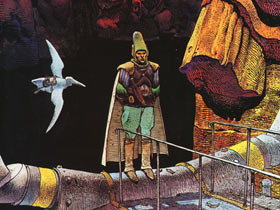
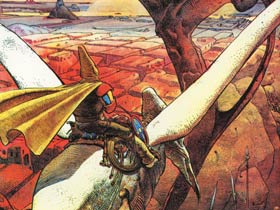
Most obviously, the player’s mission in Panzer Dragoon is never deeply explained either; we are never told what the Tower really is, for example, or why it is so important that the Dark Dragon be prevented from reaching it. Also, although some storyline elements like the bio-monsters, the Empire, and the Ancient Age are glossed over in the introductory text, they are certainly not covered in any real detail, and they remain mysterious throughout the game. Where Arzach has no dialogue, Panzer Dragoon has virtually no dialogue, and as the background story is never deeply explored a similar effect is achieved. The result of all this is that the player experiences Panzer Dragoon (and also Panzer Dragoon Zwei) in much the same way that a reader journeys through the world of Arzach; a sense of mystery, eeriness and wonder emerges first and foremost.
Contrasts
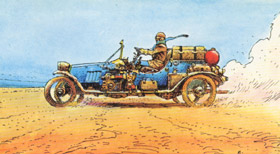
As much as I’ve focused on the parallels between Panzer Dragoon and Arzach in this article though, Team Andromeda were influenced by many other things besides Moebius’ work, and there are also many elements in the comic strips that Team Andromeda didn’t draw upon. Although the two series may seem similar on the surface, there are some fairly large differences between their general premises; the Panzer Dragoon games tend to revolve around aerial combat, with the hero wielding a gun and the dragon playing the role of a living weapon, but such battles don’t take place in the Arzach world. Arzach himself is only lightly armed, and his pterodactyl is really just a means of transportation that carries him from one fantastical scene to the next.
The differences between the games and Moebius’ comic strips only seem to grow with Panzer Dragoon Saga and Panzer Dragoon Orta, too. These games explore the storyline and setting of the Panzer Dragoon series in explicit detail; while the minimal scripts of Panzer Dragoon and Panzer Dragoon Zwei echoed the mysterious atmosphere of Arzach, the thousands of lines of dialogue, descriptions and explanations in Panzer Dragoon Saga create a very different experience. This certainly isn’t a bad thing for either series, of course, but it’s one of the major ways in which they ultimately differ.
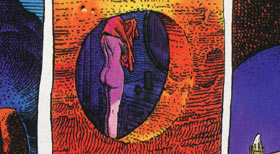
The Arzach strips are actually very short – the four stories add up to only thirty-two pages – and the events they depict are much more quirky and bizarre than the things that take place in the Panzer Dragoon storylines; Moebius’ world ultimately feels more surreal, more dream-like and more abstract than Team Andromeda’s. Like a fair few of Moebius’ creations, Arzach also features a considerable amount of nudity, and Arzach himself seems to be preoccupied with the pursuit of scantily-dressed women; predictably, the Panzer Dragoon games don’t replicate this aspect at all. The Arzach strips do seem to be full of sexualised imagery in general, too, so even where there is no literal nudity there are often visual aspects that Freud would have no difficulty reading a deeper meaning into; one of the most obvious ways to interpret Arzach as a work of art would be to view it as a continuous chain of visual metaphors. An in-depth analysis of the abstract meanings that might underlie Arzach would go somewhat beyond the scope of this article, though.
Moebius’ Involvement with Panzer Dragoon
I’m sure some of you will have noticed that Moebius’ name actually appears in the credits for the first Panzer Dragoon game, under the cryptic heading “Image Illustrations”. What Moebius contributed to the project may not be particularly obvious though, as the only illustrations obviously associated with the game (the ones displayed during the credits sequence itself) are credited to a different artist. During the development of Panzer Dragoon Orta though, two prominent ex-Team Andromeda members – Takashi Iwade and Kentaro Yoshida – were interviewed by Xbox Nation, and they shed light on this small mystery. The full interview can be found in Xbox Nation Issue 6 (February 2003).
Xbox Nation: How did the renowned French artist Moebius fit into the Panzer Dragoon creative process?
Takashi Iwade: Back then the team members were big fans of Moebius, and what actually happened is that Sega developed all of the game’s enemies and bosses, and sent them to Moebius, who had been commissioned to do some illustrative art. He interpreted the designs and the results became the cover art for the Japanese release.
Kentaro Yoshida: As we were such big fans of Moebius, we were surprised with the results because they were not as abstract as we expected. It was very in keeping with the game.
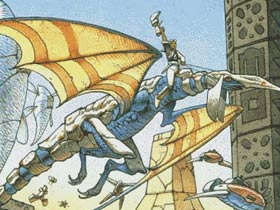
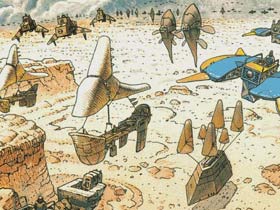
Details of these pieces of artwork are shown above, and they clearly feature Moebius’ distinctive style applied to the Panzer Dragoon world. The first piece of artwork appeared on the front cover of the Japanese game box, and also on the game disc itself, while the second piece was used on the back cover of the box. You can view larger versions of these images by clicking on the links below; notice how Kyle is riding the Blue Dragon with reins in the first image, just as Arzach rode his pterodactyl:
- Blue Dragon
- Imperial Fleet
- The front of the Japanese game box
- The back of the Japanese game box
- The Japanese game disc
All illustrations on this page are copyright © Jean Giraud / Moebius. Thanks go to The Art of Panzer Dragoon for providing the “full” artwork images.
